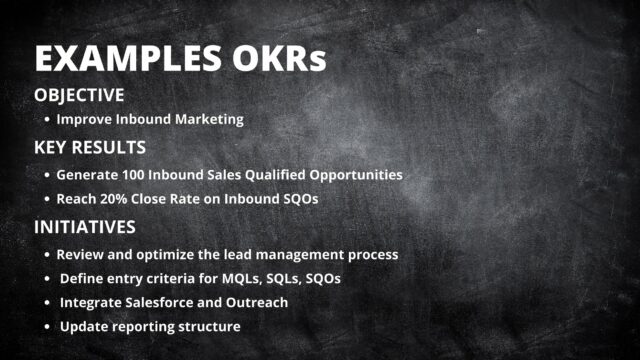
Building a RevOps Roadmap
Read time: 9 minutes“My head of RevOps is never thinking strategically.”
“I assumed she’d be coming to me with ideas, identifying opportunities to make improvements and that’s not happening.”
This is a conversation I’ve had many times with CROs and VPs of Sales.
RevOps pros say the same. They want to be strategic but can’t!
When I dig into these conversations I find:
- This person is personally managing the entire revenue tech stack
- They’re managing enablement, fielding questions all day long
- Requests for updates and reports flood in all day every day
- They get constant interruptions through multiple channels
- Everything is a fire-drill, everything is an urgent priority
- So, if everything is a priority, really nothing is a priority
- And there’s never any time to do any strategic work
Strategic work requires planning, prioritization and protected, uninterrupted time to focus on deep work. How do you do that in hyper-growth organizations when everything is always on fire?
The solution includes many factors:
- Alignment with Executive Leadership
- A single Intake System for all requests to go
- A Service Level Agreement for request response
- A Strategic Revenue Operations Roadmap to prioritize
- Scheduled Sprint Planning to prioritize work in the Roadmap
- The ability to say no to additional requests not in the Roadmap
- Protected, uninterrupted time to focus on the deep strategic work
There’s a lot there, but the foundation of this is having a strategic plan for RevOps, a Revenue Operations Roadmap, and aligning with Executive Leadership on that Roadmap.
Here’s how our team builds these roadmaps with each of our customers.
Step 1 – Define Objectives and Priorities

First, we start with the end in mind, defining the strategic objectives and priorities for the Revenue Team.
We ask leadership questions like:
- What specifically do we want to accomplish this year?
- What is our Go To Market Strategy and how will it evolve?
- How will our Revenue Team grow, evolve, and change this year?
- What does the Revenue Team need to improve this year to execute?
- What are the top 3-5 priorities we should focus on this coming quarter?
OKRs
One strategic planning framework we’re big fans of is OKRs, or Objectives and Key Results, made famous by companies like Google, who started using it in the very early days.
OKRs include three things:
- Objectives – High Level Goals, or Priorities
- Key Results – Specific, measurable results for these Objectives
- Initiatives – The projects and tasks we will execute to achieve them.

Whether we use OKRs, another framework, or just keep it simple and outline our priorities, the most important part is clearly understanding what it is we hope to accomplish and why, and then achieve alignment with leadership on this plan.
This is the only way RevOps can rise above the daily food of requests and push back on distractions by saying “We have to focus on these priorities now.”
Step 2 – Define Key Results and Insights
Starting with the end in mind includes thinking about how we will actually measure our results with the data in our systems. These are the Key Results in our OKRs.
At the end of the quarter, how will we look back to measure our success in each initiative?

Insights are more than data and reports. They require focussed time to make meaning of that data and those reports and translate them into a concise story busy leaders can easily understand. By answering these questions now, we force ourselves to include Insights into our planning and architecture for each Initiative or Project. This also makes it easier to block protected time to analyze the data and deliver those Insights to leadership.
Step 3 – Define Initiatives or Projects and Tasks
We need to execute Initiatives, or simply Projects and Tasks, to achieve our Objectives and Key Results. This is the core of our Roadmap and defines where we should spend the majority of our time in RevOps over the coming quarter.
In defining these Initiatives, it’s important we define the specific requirements for each deliverable, expected timeline to deliver it, and the priority for each so that we can have an informed framework to drive regular Sprint Planning.
Step 4 – Prioritize All of The Above
We now have a list of all the things we need to do and need to prioritize that list according to their impact to the company, the Revenue Team, and their respective priorities.
If we could only get one of these done next quarter, which would it be? By stack ranking each item in our list we can achieve better alignment with Executive Leadership and have a greater ability to push back on distractions so that we can get the most important work done.
We usually start by taking a first pass at what we think the priorities are before presenting this to leadership for feedback. This saves them time and makes it easier for them to provide that feedback, even when we’re wrong.
Step 5 – Present to Leadership
We should now be ready to present our draft of the RevOps Roadmap to leadership.

One key here is to know our audience and where they stand in their learning curve on RevOps. Some leaders and executive teams already have their OKRs well defined and would welcome a RevOps Roadmap with little explanation or justification. Others may be overwhelmed by some of these concepts and jargon and still view RevOps as systems admin or an IT helpdesk.
The more that leadership is in the second camp, the more we need to explain things in basic terms by simply saying “We think these are the most important things to get done next quarter to help the Revenue Team achieve their goals. Can you tell us if this is where you’d like us to invest our time or if you have something else in mind?”
I’ve yet to meet a leader that doesn’t want their subordinates to come to a meeting with a plan for their work. It can start out being that simple and grow, as leadership sees value and better understands how RevOps works.
After this meeting, and possibly some revisions, we should have our RevOps Roadmap.
Step 6 – Roll Into Sprint Planning
Now that we have a Roadmap, we need to execute it by doing the work each week, or each Sprint Cycle.
We will still have our flood of requests, though, so we need to block time to review those requests and set our plan for each Sprint. If requests fall into the priorities we outlined in the Roadmap, they can be added to the requirements for an Initiative we already have on the list and prioritized accordingly. If they fall outside our Roadmap, we need to ask our stakeholders if they want items on the Roadmap to be delayed in order to prioritize these new requests.
We often position this by saying something like “We can take care of this request in this Sprint, but if we do, these other items will have to wait. Is that okay?”
In an ideal world we’d have enough trust from leadership to make that call ourselves but this is different in every company and we have to work with what we’ve got.
Step 7 – Schedule Regular Insights and Quarterly Business Reviews
Our last step here is to ensure we maintain the alignment we built with leadership and build on it by keeping them engaged and continuously delivering value to them. The best way to do this is to schedule regular meetings to deliver Insights into what’s working and not working in our Revenue Engine and reviewing our Roadmap at least quarterly, but doing a Quarterly Business Review.
The only way to do this is to have protected, uninterrupted time and the best way to do this is to set a deadline for these deliverables by scheduling these recurring meetings.
In these meetings we want to discuss with leadership:
- What’s working and not working in the Revenue Engine
- What we should do about it, the work in RevOps do be done
- What Initiatives have been completed on the RevOps Roadmap
- What Key Results have been achieved completing these Initiatives
- How our GTM Strategy and our RevOps Roadmap need to evolve next
This is the key that allows RevOps to be strategic. As leadership sees valuable, tangible Insights delivered to them on a regular basis, alongside strategic planning, they will start to see RevOps as a strategic advisor more and more every day and prioritize this strategic work over greasing the squeakiest wheel every day.
SUMMARY
- Define Objectives and Priorities
- Define Key Results and Insights
- Define Initiatives or Projects and Tasks
- Prioritize All of the Above
- Present to Leadership
- Roll Into Sprint Planning
- Schedule Regular Insights and Quarterly Business Reviews
With this in place:
- RevOps can finally be strategic and drive meaningful impact
- Leadership is clear on what RevOps is doing and why it’s important
- Leadership is getting regular Insights from the data into what’s working
- The rest of the team understands the priorities and what to expect from RevOps
- RevOps can then block protected, uninterrupted time to do the deep strategic work
- Most importantly, the Revenue Team has a strategic ally to help grow revenue faster
When you’re ready, here’s how we can help:
Get a Free 1:1 Revenue Efficiency Workshop
Get one of our Senior Revenue Strategists to yourself for 1 hour and leave with a plan to increase the money-making power of your go-to-market operations.
Hire Us!
Bring us on as your Strategic RevOps Team and realize the growth potential of your revenue engine. There are 3 ways to work with us.
Get more tips like these, sent right to your inbox.
Subscribe for fresh, relevant revenue growth tips delivered every week.